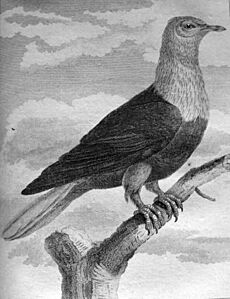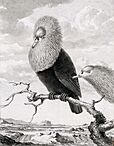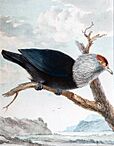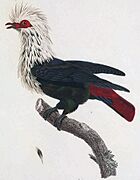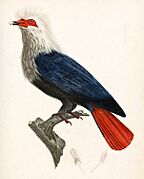Mauritius blue pigeon facts for kids
Quick facts for kids Mauritius blue pigeon |
|
|---|---|
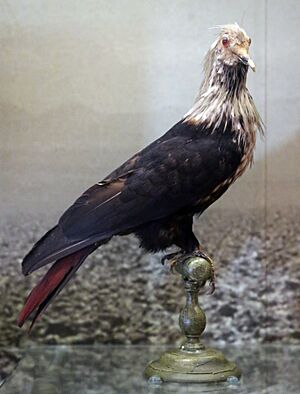 |
|
| Mounted skin in the National Museum of Scotland, one of three in existence | |
| Conservation status | |
| Scientific classification | |
| Genus: |
Alectroenas
|
| Species: |
nitidissimus
|
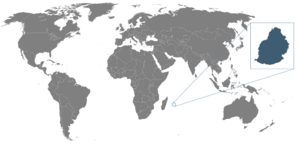 |
|
| Location of Mauritius in blue | |
| Synonyms | |
|
List
Columba nitidissima Scopoli, 1786
Columba franciae Gmelin, 1789 Columba batavica Bonnaterre, 1790 Columba jubata Wagler, 1827 Alectroenas franciae Gray, 1840 Alectroenas nitidissimus Columbigallus franciae Des Murs, 1854 Ptilopus nitidissimus Schlegel & Pollen, 1868 |
|
The Mauritius blue pigeon (Alectroenas nitidissimus) was a beautiful bird that lived only on the island of Mauritius in the Indian Ocean. It is now extinct, meaning there are no more left in the world. This pigeon was known for its bright colors: white feathers around its head and neck, a blue body, and a red tail. People thought its colors looked like the Dutch flag, which is why it was sometimes called "Dutch Pigeon."
This pigeon was about 30 cm (12 in) long. It was bigger and stronger than other blue pigeons. It ate fruits, nuts, and even some molluscs. The Mauritius blue pigeon used to live all over the forests of Mauritius. It disappeared around the 1830s because its forest home was cut down and other animals hunted it.
Contents
Discovering the Mauritius Blue Pigeon
The first time anyone recorded the Mauritius blue pigeon was in a Dutch ship's journal from 1601–1603. An artist named Joris Joostensz Laerle drew two sketches of the birds on Mauritius. These drawings were not published until 1969.
In 1651, François Cauche briefly mentioned "white, black and red turtle doves." This is thought to be the first clear mention of the bird. Later, in the mid-1700s, Jean-François Charpentier de Cossigny also wrote about it.
How the Bird Got Its Name
The French naturalist Pierre Sonnerat described the bird in 1782. He called it Pigeon Hollandais, which means "Dutch pigeon." This name came from its red, white, and blue colors, which reminded people of the Dutch flag. Sonnerat collected two specimens during a trip in 1774.
Since Sonnerat wrote in French, the official scientific name came from Giovanni Antonio Scopoli. In 1786, he gave the bird the Latin name Columba nitidissima. This means "most brilliant pigeon."
In 1840, the English zoologist George Robert Gray created a new genus (a group of related species) called Alectroenas for the Mauritius blue pigeon. The name Alectroenas comes from Greek words meaning "domestic cock" and "dove." The Mauritius blue pigeon is the main species of this group, which includes all blue pigeons.
Surviving Specimens
Only three stuffed specimens of the Mauritius blue pigeon still exist today. One arrived in Paris in 1800. It was later sent to Edinburgh and is now in the National Museum of Scotland. Another specimen was shot in 1826 and is now in the Mauritius Natural History Museum in Port Louis.
Scientists have also found subfossil remains (old bones) of the Mauritius blue pigeon. These were found in swamps and near mountains on Mauritius.
Blue Pigeon Family Tree
Blue pigeons from the Alectroenas group are closely related. They live on different islands in the western Indian Ocean. There are three species still alive today: the Madagascar blue pigeon, the Comoros blue pigeon, and the Seychelles blue pigeon.
The three Mascarene islands (Mauritius, Rodrigues, and Réunion) each had their own blue pigeon species. All three are now extinct. The Mauritius blue pigeon was one of them.
Blue pigeons are medium to large birds with strong bodies and long wings and tails. They all have special feathers on their head and neck that can move. Scientists believe these pigeons traveled between islands, slowly evolving into different species. Their closest living relative is the cloven-feathered dove from New Caledonia.
Confused Identities: The Seychelles Blue Pigeon
Around 1790, a blue pigeon from Mauritius was brought to the Netherlands. It lived for three months in a special animal collection. The only known drawings of a living Mauritius blue pigeon were thought to be of this bird. They were drawn by Gijsbertus Haasbroek. The drawings show a male bird raising its neck feathers like a collar. Other blue pigeons do this too.
However, in 2020, researchers realized that the bird in Haasbroek's drawings was actually a Seychelles blue pigeon. The drawings showed a red forehead and a dark blue tail, which are features of the Seychelles blue pigeon, not the Mauritius blue pigeon. The Mauritius blue pigeon had a white crown and a red tail. Even though the bird was reported as coming from Mauritius, it might have been shipped there from the Seychelles first.
What the Mauritius Blue Pigeon Looked Like
The feathers on the head, neck, and chest of the Mauritius blue pigeon were shiny white. They were long and pointed, especially around the neck. A bright red patch of bare skin was around its eyes and extended to its beak. The beak was greenish with a dark tip.
The rest of its body was a deep blue color. Its back, shoulders, and wings were a metallic blue. The tail feathers were a dark red, like maroon. Its legs were dark gray. The bird's eyes were reddish-orange with a yellow ring inside.
This pigeon was about 30 cm (12 in) long. It was the biggest and strongest of all the blue pigeons. Its neck feathers were longer and covered more area than those of other blue pigeons. Some people thought young Mauritius blue pigeons might have had green feathers, similar to young Seychelles and Comoro blue pigeons.
Some old pictures and descriptions show the pigeon with red legs. However, this is thought to be a mistake. The legs of the surviving specimens are not red. Also, some modern pictures show the bird with a bumpy face, like the Seychelles blue pigeon. But a report from the 1660s did mention the bird having a "warty face."
Life and Habitat
Few details are known about how the Mauritius blue pigeon behaved. It probably lived in pairs or small groups in humid, mountainous forests. This is how its relatives that are still alive today live. Old bones show that the bird used to be found all over Mauritius.
By 1812, people said that only single birds could be found in river valleys. The bird likely became rarer during French rule (1715–1810). During this time, most of the lowland forests on the island were cut down.
Many other unique animals on Mauritius also became extinct after humans arrived. The island's natural environment is now very damaged. Before humans, forests covered all of Mauritius. Today, very little forest remains.
The Mauritius blue pigeon lived alongside other extinct Mauritian birds. These included the dodo, the red rail, and the broad-billed parrot. Extinct Mauritian reptiles included giant tortoises.
What the Mauritius Blue Pigeon Ate
Fruits and nuts were likely the main food for the Mauritius blue pigeon. Like other blue pigeons, it probably lived in the tops of trees. It might have moved around with the seasons to find food.
In the mid-1700s, Cossigny examined a pigeon's stomach. He found four "nuts" inside. These were likely seeds from local trees like Calophyllum tacamahaca. Other blue pigeons also eat these seeds. Their strong stomachs help them digest the seeds.
In 1812, Jacques Gérard Milbert described seeing the bird in the wild. He said it lived alone in river valleys and ate fruit and freshwater molluscs. Some scientists doubted it ate molluscs because pigeons usually eat fruit. However, some fruit-eating pigeons do sometimes eat snails or other small creatures. Eating snails would give the birds calcium for their eggs.
An early attempt to keep these pigeons in captivity failed. This is probably because they mostly ate fruit, and their special diet was hard to provide.
Why the Mauritius Blue Pigeon Disappeared
The Mauritius blue pigeon lived alongside humans for about 200 years. Its numbers went down as forests were cut down. This is also a big problem for blue pigeons today. By 1859, very little lowland forest was left on Mauritius.
Fruit-eating birds often need a large area to find food. They move between different types of forests to find various foods. Blue pigeons often sit on bare branches, which makes them easy targets for hunters.
Cossigny noticed that the bird was rare by 1755. He said it was common 23 years before that. He blamed its decline on trees being cut down and hunting by escaped slaves. However, Bonnaterre said they were still common in 1790.
Even though some people thought the bird was poisonous, it was still hunted for food. Early accounts said it tasted good. Blue pigeons today are also hunted a lot. The Mauritius blue pigeon was easy to catch because it was not afraid of humans. This is called "island tameness."
The last confirmed bird was shot in 1826. But a report from 1832 suggested some might still be found in remote forests. In 1863, a British scientist interviewed people on Mauritius. They said the bird might have survived until at least 1837. One woman remembered hunting them around 1815. She said they were so tame that her father could hit them with sticks instead of shooting them.
She described the last one she saw around 1837. It was brought out of the forest by a runaway slave. She said it was larger than a regular pigeon and had "all the colours of the rainbow," especially on its head.
It is believed that the Mauritius blue pigeon became extinct in the 1830s. Besides losing their homes and being hunted, new animals brought to the island, like crab-eating monkeys, also helped cause their extinction.



